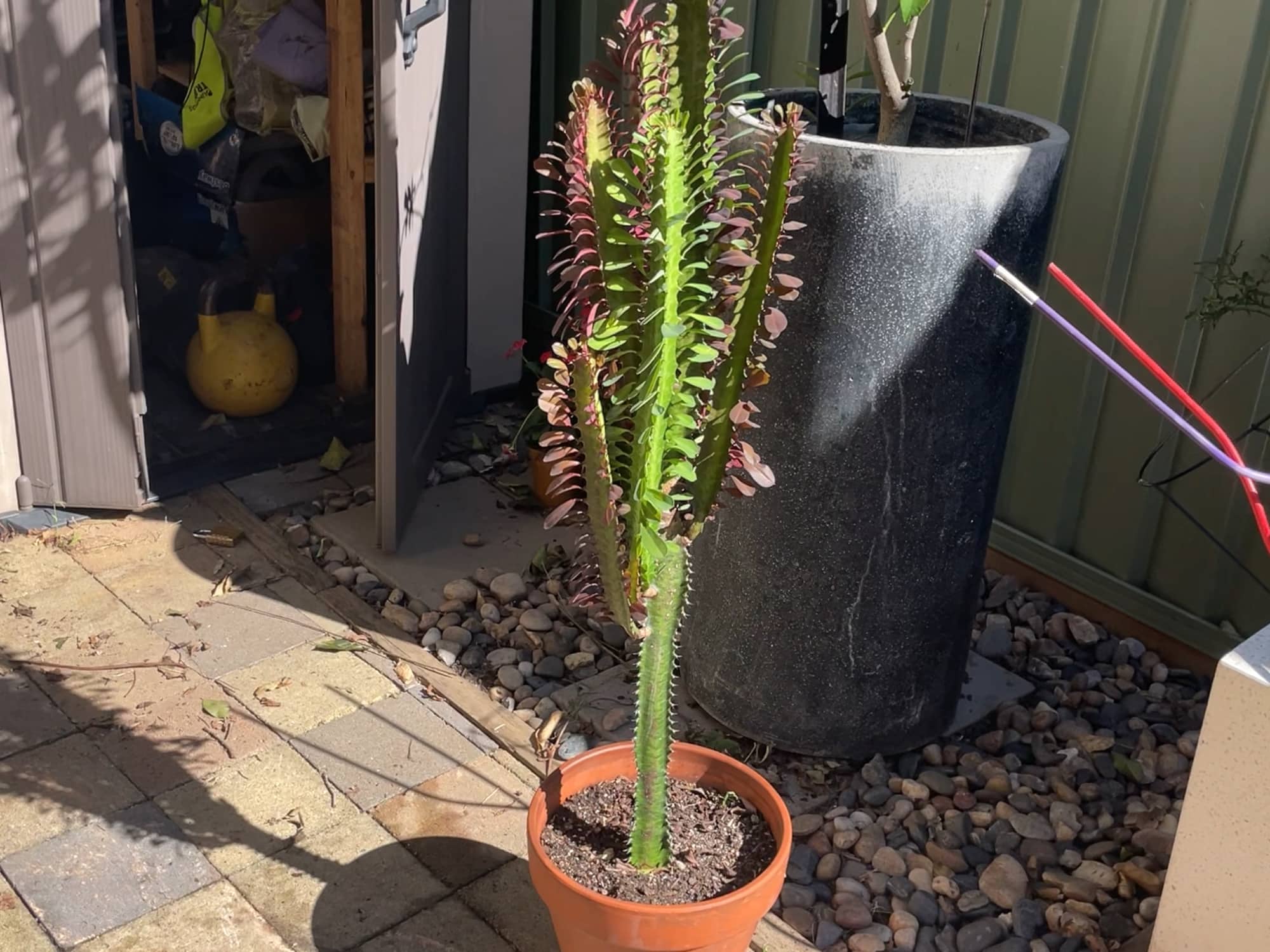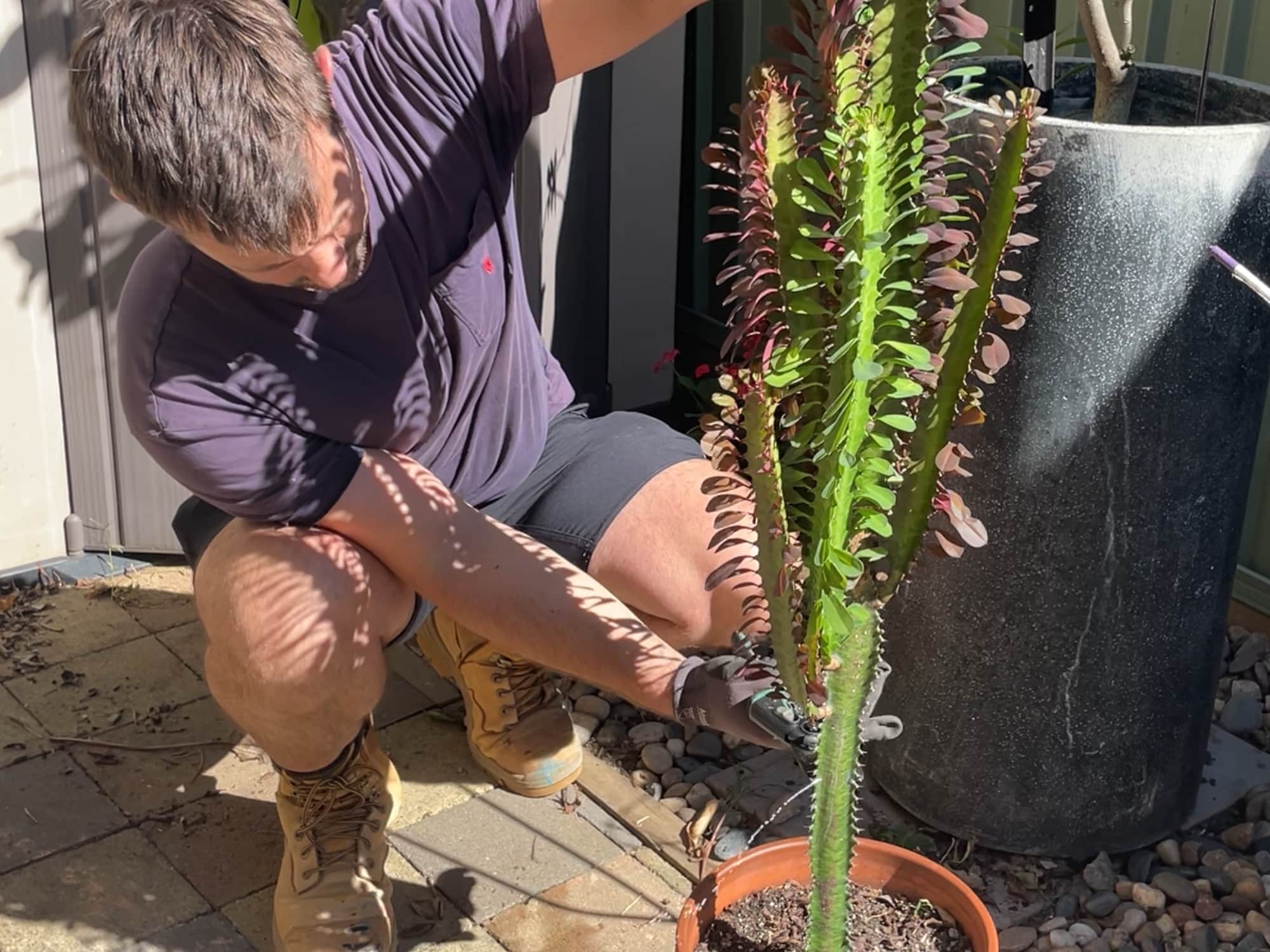If your African milk tree (Euphorbia Trigona) is starting to get too tall for its space, or if it is too top-heavy, yes, you can cut the top of it off.
The benefits of cutting the top of your African milk tree off are:
- You now have two plants and can propagate the plant cutting by placing them into a new pot and potting mixture.
- You reduce the plants’ size making it more manageable to move around.
- Pruning branches on the African milk tree is one way to encourage it to grow extra branches. Branching not only looks good but can help the tree keep balanced.
Make sure that you use the correct tools and wear the appropriate safety equipment to avoid getting hurt by the spikes or getting the white milky sap on your skin or eyes.
Ideally, you would do this during the plants growing season when the weather is warm. But if your winters aren’t too cold and frosty then you should be ok to continue.
Things to Consider Before Cutting the Top Off
There are some pros and cons that you will need to weigh up before cutting the top off your African milk tree.
Pros
- The plant may grow extra branches where it was cut, making it more bushy.
- The tree will be easier to move around and care for.
- The tree may look better than before.
Cons
- The plant may get a disease from the open cuts, or be more affected by pests.
- The plant may not grow back.
- It may not grow additional branches.
- Removing some branches may make it unstable and lopsided.
If you still want to go ahead, follow the below steps as a guide to cutting the top off your own plant.

How to cut the top off your African milk tree (Euphorbia Trigona)
Total Time: 5 minutes
-
Setup Work Area

Before you cut the top off your plant, move it somewhere you will have plenty of space to place the cutting once you have finished.
This is your chance to prepare as well, so collect the equipment needed including secateurs, gloves, safety glasses (optional).
-
Cut Top Off

To prevent the plant from falling once you cut it, either hold onto the top of it yourself or get a friend to hold the top. When the plant is cut, holding onto the top will prevent it from falling onto you, and it will stop it from falling and damaging itself.
Then with your secateurs cut the plant at whatever level you want it to be cut.
Be careful as the plant’s white waxy sap will shoot out of the plant.
-
Cut Top Off (cont)

If you plan on propagating the cutting, place it somewhere out of the sun for 1 to 3 days so the end of it can callous over before being propagated in a new pot.
You can read my full guide on propagating African milk trees here.
-
Watering the Plant

Let the cuts on both ends of the plant dry out completely before watering. If you don’t there is a risk that the plant could rot.
-
Propagate Cutting
If you want to propagate the plant, do the following:
1. Let the cutting sit in the shade for 1 to 3 days to allow the end of it to callous over which will reduce the risk of rot.
2. Fill a pot up with a succulent potting mix and plant the cutting at least 2 inches deep.
3. Give the cutting a really good watering.
4. Do not place the cutting in direct sunlight until it has grown roots to support itself.
Tools:
- Secateurs or sharp utility knife
- Gloves
- Safety glasses
Materials: Pot Potting mix
Aftercare
These plants are very easy to take care of. If you do the following you will have no trouble after cutting the top off:
- Water frequently, but not overwatering it. Wait for the soil to dry out between watering. Root rot is the biggest risk to these plants.
- Fertilize the plant. You should fertilize these plants at least at the start of the growing season, in the summer months.
- Watch for any pests and infections where the cuts were made. If you see disease or infection, consider cutting the affected area off. If you see any pests, you could use a cotton swap dipped in alcohol to dab the pests away.
- Once these plants have established roots, they love to receive full sunlight. Until they have roots, place them in an area where they will not receive any direct, but indirect sunlight for most of the day.


